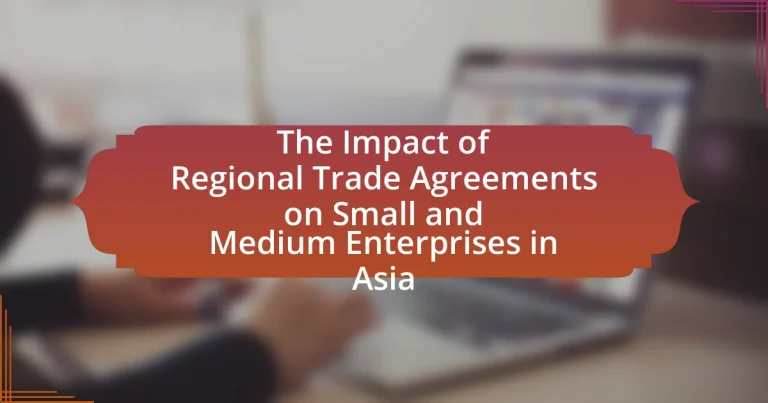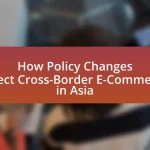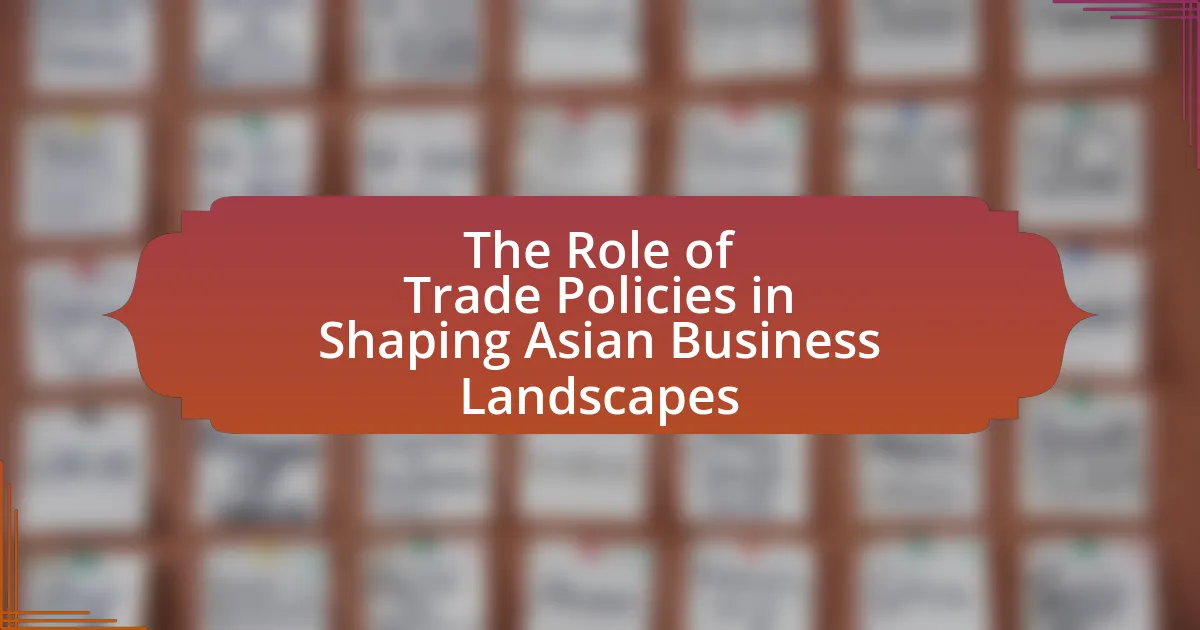Regional Trade Agreements (RTAs) play a crucial role in shaping the business landscape for Small and Medium Enterprises (SMEs) in Asia by reducing trade barriers and enhancing market access. This article examines the significance of RTAs for SMEs, highlighting their impact on competitiveness, economic growth, and job creation. It discusses specific provisions within RTAs that benefit SMEs, such as tariff reductions and trade facilitation measures, while also addressing the challenges these enterprises face, including compliance costs and limited access to financing. Furthermore, the article explores how SMEs can leverage technology and strategic practices to maximize the advantages offered by RTAs, ultimately contributing to their growth and sustainability in the global market.
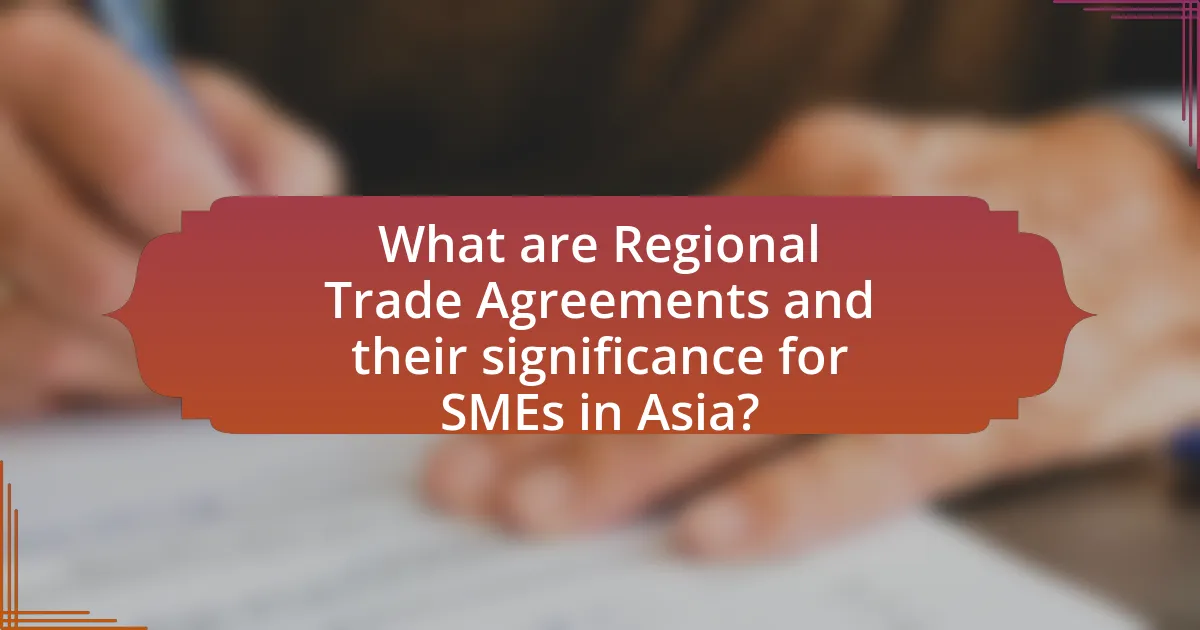
What are Regional Trade Agreements and their significance for SMEs in Asia?
Regional Trade Agreements (RTAs) are treaties between two or more countries that aim to facilitate trade by reducing tariffs and other trade barriers. For Small and Medium Enterprises (SMEs) in Asia, RTAs are significant as they provide access to larger markets, enhance competitiveness, and promote economic growth. For instance, the ASEAN Free Trade Area (AFTA) has enabled SMEs in member countries to benefit from reduced tariffs, leading to increased exports and improved supply chain efficiencies. Additionally, RTAs often include provisions for technical assistance and capacity building, which further support the development of SMEs in the region.
How do Regional Trade Agreements influence the business environment for SMEs?
Regional Trade Agreements (RTAs) significantly influence the business environment for Small and Medium Enterprises (SMEs) by reducing trade barriers and enhancing market access. These agreements often lower tariffs and eliminate quotas, allowing SMEs to enter new markets more easily and competitively. For instance, the ASEAN Free Trade Area (AFTA) has enabled SMEs in Southeast Asia to benefit from reduced tariffs, leading to increased exports and greater regional integration. Additionally, RTAs often include provisions for investment protection and intellectual property rights, which further create a more secure environment for SMEs to operate. According to a study by the Asian Development Bank, SMEs that engage in international trade through RTAs experience higher growth rates compared to those that do not, highlighting the positive impact of these agreements on their business environment.
What specific provisions in Regional Trade Agreements affect SMEs?
Specific provisions in Regional Trade Agreements (RTAs) that affect Small and Medium Enterprises (SMEs) include tariff reductions, trade facilitation measures, and provisions for technical assistance. Tariff reductions lower the cost of exporting goods, making it easier for SMEs to access foreign markets. Trade facilitation measures streamline customs procedures, reducing delays and costs associated with cross-border trade, which is particularly beneficial for SMEs that may lack resources. Additionally, provisions for technical assistance often provide SMEs with support in areas such as capacity building and compliance with international standards, enhancing their competitiveness in the global market. These provisions collectively aim to create a more favorable trading environment for SMEs, enabling them to thrive in the context of regional integration.
How do tariffs and non-tariff barriers impact SMEs under these agreements?
Tariffs and non-tariff barriers significantly impact SMEs under regional trade agreements by influencing their market access and competitiveness. Tariffs increase the cost of imported goods, making it harder for SMEs to compete with larger firms that can absorb these costs more effectively. For instance, a study by the Asian Development Bank found that high tariffs can reduce the export potential of SMEs by up to 30%, limiting their growth opportunities. Non-tariff barriers, such as stringent regulations and standards, further complicate market entry for SMEs, often requiring them to invest in compliance measures that larger companies can more easily manage. This creates an uneven playing field, where SMEs struggle to navigate complex trade environments, ultimately hindering their ability to expand and innovate.
Why are Small and Medium Enterprises important to the Asian economy?
Small and Medium Enterprises (SMEs) are crucial to the Asian economy because they contribute significantly to employment, innovation, and economic growth. SMEs account for approximately 97% of all businesses in Asia and provide around 60% of total employment in the region. This high employment rate underscores their role in job creation and economic stability. Furthermore, SMEs drive innovation by introducing new products and services, which enhances competitiveness in the market. According to the Asian Development Bank, SMEs contribute about 30% to the GDP of many Asian countries, highlighting their importance in fostering economic development and resilience.
What role do SMEs play in job creation and economic growth in Asia?
Small and medium enterprises (SMEs) are crucial for job creation and economic growth in Asia, accounting for approximately 97% of all businesses and providing around 60% of total employment in the region. SMEs contribute significantly to GDP, with estimates suggesting they generate about 40% of the total economic output in many Asian countries. Their ability to innovate and adapt to local markets enables them to create diverse job opportunities, particularly in rural and underserved areas, thus reducing unemployment rates. Furthermore, SMEs often benefit from regional trade agreements, which enhance their access to larger markets, increase competitiveness, and stimulate further economic development.
How do SMEs contribute to innovation and competition in the market?
Small and medium enterprises (SMEs) contribute to innovation and competition in the market by fostering creativity, agility, and niche specialization. SMEs often introduce new products and services, leveraging their flexibility to adapt quickly to market changes, which enhances competitive dynamics. For instance, according to the OECD, SMEs account for 70% of all jobs in many countries and are responsible for a significant portion of new job creation, indicating their role in driving economic growth and innovation. Furthermore, SMEs often collaborate with larger firms and research institutions, facilitating knowledge transfer and technological advancements, which further stimulates competition and innovation in the market.

What challenges do SMEs face in the context of Regional Trade Agreements?
Small and medium enterprises (SMEs) face several challenges in the context of Regional Trade Agreements (RTAs), including limited access to information, compliance costs, and increased competition. Limited access to information hinders SMEs from understanding the benefits and requirements of RTAs, which can lead to missed opportunities for market expansion. Compliance costs arise from the need to meet various regulatory standards and documentation requirements imposed by RTAs, which can disproportionately burden smaller firms with fewer resources. Additionally, increased competition from larger firms and foreign entrants can threaten the market share of SMEs, as these entities often have greater capabilities to leverage the advantages provided by RTAs. According to a study by the Asian Development Bank, SMEs in Asia often struggle to adapt to the complexities of RTAs, which can stifle their growth and competitiveness in the global market.
How do compliance and regulatory issues affect SMEs?
Compliance and regulatory issues significantly affect SMEs by imposing additional costs and operational complexities. These businesses often lack the resources to navigate intricate regulations, which can lead to non-compliance and potential penalties. For instance, a study by the Asian Development Bank found that SMEs in Asia face higher compliance costs relative to their larger counterparts, which can consume up to 30% of their operational budget. This financial strain can hinder growth, limit market access, and reduce competitiveness in the global market.
What are the common regulatory hurdles SMEs encounter?
Small and medium enterprises (SMEs) commonly encounter regulatory hurdles such as complex compliance requirements, high costs of regulatory adherence, and inconsistent enforcement of regulations. These challenges arise from the need to navigate various local, national, and international laws, which can be particularly burdensome for SMEs with limited resources. For instance, a report by the Asian Development Bank highlights that SMEs often struggle with understanding and meeting the diverse regulatory standards set by different countries, leading to increased operational costs and potential market entry barriers. Additionally, the lack of support and guidance from government agencies exacerbates these issues, making it difficult for SMEs to remain competitive in the global market.
How can SMEs navigate complex compliance requirements?
SMEs can navigate complex compliance requirements by implementing a structured compliance management system that includes regular training, consultation with legal experts, and leveraging technology for monitoring regulations. A structured approach allows SMEs to stay updated on changing laws and regulations, which is crucial given that 70% of SMEs report difficulty in understanding compliance obligations. Regular training ensures that employees are aware of compliance standards, while consulting legal experts provides tailored guidance specific to the industry and region. Additionally, utilizing compliance management software can automate tracking and reporting, reducing the risk of non-compliance.
What financial challenges do SMEs face when engaging in international trade?
SMEs face several financial challenges when engaging in international trade, including limited access to financing, currency fluctuations, and high transaction costs. Limited access to financing restricts SMEs from securing the necessary capital to expand operations or invest in new markets, as traditional lenders often perceive them as high-risk. Currency fluctuations can lead to unpredictable costs and revenues, complicating financial planning and potentially eroding profit margins. Additionally, high transaction costs, including tariffs, shipping fees, and compliance with foreign regulations, can significantly impact the overall profitability of international trade for SMEs. These challenges are well-documented, with studies indicating that SMEs often struggle to compete on a global scale due to these financial barriers.
How do access to finance and credit constraints impact SMEs?
Access to finance and credit constraints significantly hinder the growth and sustainability of small and medium enterprises (SMEs). Limited access to financial resources restricts SMEs from investing in essential areas such as technology, workforce, and market expansion, which are crucial for competitiveness. According to the World Bank, approximately 70% of SMEs in developing countries lack access to adequate financing, which directly correlates with lower productivity and innovation levels. Furthermore, credit constraints often lead to higher operational costs and reduced ability to respond to market opportunities, ultimately stifling economic growth and job creation within the region.
What financial support mechanisms are available for SMEs under Regional Trade Agreements?
Financial support mechanisms available for SMEs under Regional Trade Agreements (RTAs) include access to preferential financing, grants, and technical assistance programs. These mechanisms are designed to enhance the competitiveness of SMEs by providing them with financial resources that can be utilized for expansion, innovation, and market access. For instance, the ASEAN Trade in Goods Agreement (ATIGA) facilitates lower tariffs and provides financial incentives for SMEs to engage in cross-border trade, thereby promoting their growth and sustainability. Additionally, various RTAs often include provisions for capacity-building initiatives, which equip SMEs with the necessary skills and knowledge to navigate international markets effectively.
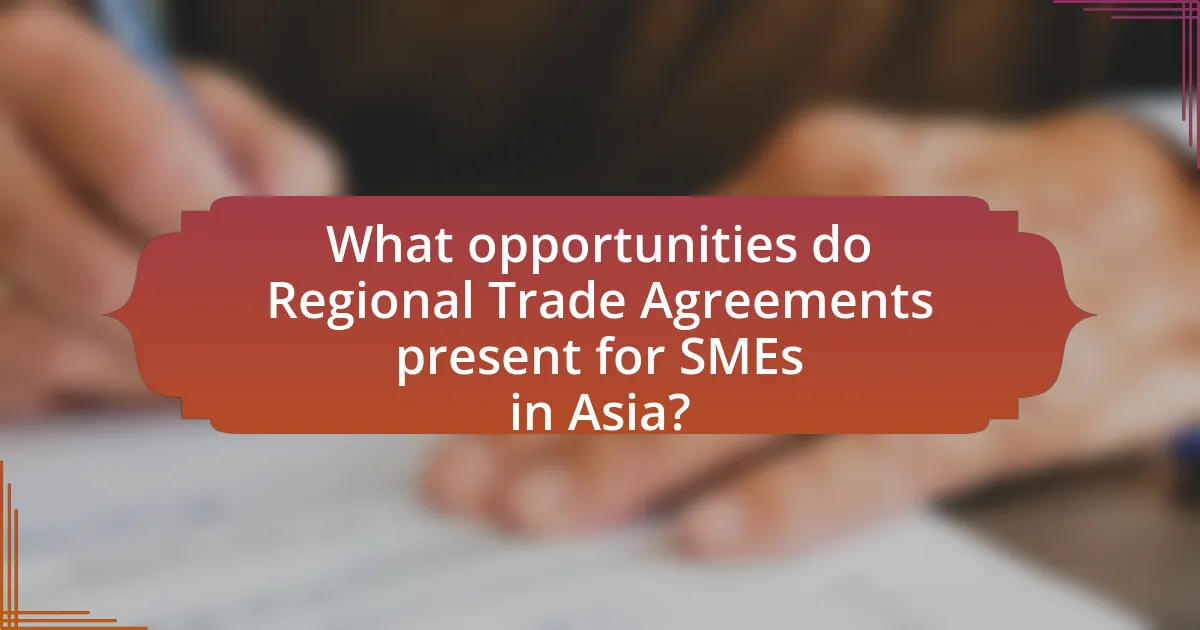
What opportunities do Regional Trade Agreements present for SMEs in Asia?
Regional Trade Agreements (RTAs) present significant opportunities for Small and Medium Enterprises (SMEs) in Asia by facilitating access to larger markets, reducing trade barriers, and enhancing competitiveness. These agreements often lower tariffs and simplify customs procedures, allowing SMEs to export their products more easily and at lower costs. For instance, the ASEAN Free Trade Area has enabled SMEs in member countries to benefit from reduced tariffs on goods, which can increase their market reach and profitability. Additionally, RTAs often include provisions for technical assistance and capacity building, which help SMEs improve their operational efficiency and adapt to international standards. This support is crucial for SMEs, as they typically lack the resources to navigate complex trade regulations independently.
How can SMEs leverage Regional Trade Agreements to expand their markets?
SMEs can leverage Regional Trade Agreements (RTAs) to expand their markets by gaining access to reduced tariffs and improved trade conditions with partner countries. These agreements often eliminate or lower trade barriers, allowing SMEs to export their products at more competitive prices. For instance, the ASEAN Free Trade Area (AFTA) has enabled SMEs in Southeast Asia to increase their market reach by facilitating easier access to member countries, resulting in a 20% increase in intra-regional trade among SMEs since its implementation. Additionally, RTAs often provide SMEs with better access to information and resources, such as trade facilitation programs and capacity-building initiatives, which can enhance their ability to navigate foreign markets effectively.
What strategies can SMEs adopt to take advantage of reduced tariffs?
SMEs can adopt several strategies to take advantage of reduced tariffs, including optimizing supply chains, enhancing product competitiveness, and expanding market reach. By optimizing supply chains, SMEs can source materials from countries with lower tariffs, thereby reducing production costs. Enhancing product competitiveness involves improving quality and innovation to meet the demands of new markets that become accessible due to reduced tariffs. Expanding market reach can be achieved by entering new regional markets that benefit from trade agreements, allowing SMEs to increase their customer base and sales. These strategies enable SMEs to leverage tariff reductions effectively, fostering growth and sustainability in a competitive landscape.
How can SMEs utilize trade facilitation measures to enhance competitiveness?
SMEs can utilize trade facilitation measures to enhance competitiveness by streamlining their export and import processes, which reduces costs and improves efficiency. By taking advantage of simplified customs procedures, SMEs can decrease the time and resources spent on compliance, allowing them to focus on core business activities. For instance, the World Bank’s “Doing Business” report highlights that countries implementing trade facilitation measures can reduce trade costs by up to 15%, significantly benefiting SMEs that often operate with tighter margins. Additionally, access to information on trade regulations and market opportunities through trade facilitation initiatives enables SMEs to make informed decisions, thus enhancing their market reach and competitiveness in the regional and global markets.
What role does technology play in helping SMEs benefit from Regional Trade Agreements?
Technology plays a crucial role in enabling SMEs to leverage Regional Trade Agreements (RTAs) by facilitating access to new markets and streamlining operations. Digital platforms and tools allow SMEs to efficiently navigate regulatory requirements, manage supply chains, and engage in e-commerce, which enhances their competitiveness in international markets. For instance, the use of cloud-based software can help SMEs manage logistics and compliance with trade regulations more effectively, reducing costs and time associated with cross-border trade. Additionally, data analytics enables SMEs to identify market trends and customer preferences, allowing them to tailor their offerings to meet the demands of different regions. According to a report by the Asian Development Bank, SMEs that adopt technology can increase their export potential by up to 20%, demonstrating the significant impact of technology in maximizing the benefits of RTAs.
How can digital tools and e-commerce platforms support SMEs in international trade?
Digital tools and e-commerce platforms support SMEs in international trade by providing access to global markets, enhancing operational efficiency, and facilitating communication. These platforms enable SMEs to reach international customers without the need for a physical presence, significantly reducing entry barriers. For instance, according to a report by the International Trade Centre, SMEs that utilize e-commerce are 50% more likely to export than those that do not. Additionally, digital tools streamline logistics and payment processes, allowing SMEs to manage cross-border transactions more effectively. This integration of technology not only broadens market access but also improves competitiveness in the global landscape.
What are the best practices for SMEs to adopt technology effectively?
Small and medium enterprises (SMEs) can adopt technology effectively by implementing a strategic approach that includes assessing their specific needs, investing in training, and leveraging partnerships. First, SMEs should conduct a thorough needs assessment to identify the technologies that align with their business goals and operational challenges. For instance, a study by the International Finance Corporation found that 70% of SMEs that adopted technology tailored to their specific needs reported increased productivity.
Next, investing in employee training is crucial, as it ensures that staff can utilize new technologies efficiently. According to a report by the World Bank, SMEs that provided training saw a 30% improvement in technology adoption rates.
Finally, forming partnerships with technology providers or other businesses can facilitate access to resources and expertise, enhancing the implementation process. Research from the Asian Development Bank indicates that SMEs engaged in collaborative networks are 50% more likely to successfully integrate new technologies. These practices collectively enable SMEs to navigate the complexities of technology adoption effectively.
What are the best practices for SMEs to maximize benefits from Regional Trade Agreements?
Small and medium enterprises (SMEs) can maximize benefits from Regional Trade Agreements (RTAs) by actively engaging in market research, leveraging trade facilitation measures, and utilizing available support programs. Conducting thorough market research allows SMEs to identify new opportunities and understand the competitive landscape in partner countries, which is crucial for strategic decision-making. Additionally, SMEs should take advantage of trade facilitation measures, such as simplified customs procedures and reduced tariffs, which can lower operational costs and enhance market access. Furthermore, utilizing government and institutional support programs, including training and financial assistance, can help SMEs navigate the complexities of international trade and improve their competitiveness. These practices are supported by studies indicating that SMEs that engage in proactive strategies in response to RTAs experience higher growth rates and increased export volumes.
